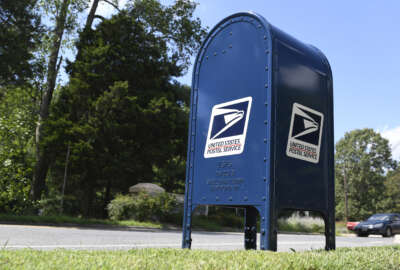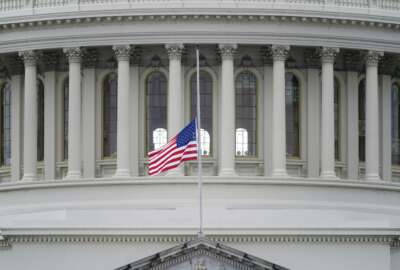
USPS sends first RIF notices to non-union employees, seeks to raise mail prices above inflation
The Postal Service sent its first reduction in force notices to non-union management employees, while the Senate confirmed Biden's third USPS board pick.
Best listening experience is on Chrome, Firefox or Safari. Subscribe to Federal Drive’s daily audio interviews on Apple Podcasts or PodcastOne.
The Postal Service sent its first reduction in force notices to non-union management employees Friday, and is planning to set higher prices on its mail products well above the rate of inflation.
The Senate, meanwhile, voted to confirm President Joe Biden’s third nominee to serve on the USPS Board of Governors. The board is now fully staffed for the first time since 2010, and will help the agency get its 10-year reform plan off the ground.
USPS employees working at its headquarters, or area and district offices, have known for nearly a month that a non-voluntary RIF has been on the horizon. A memo obtained and first reported by Federal News Network notified employees that RIF notices would go out as early as May 21.
However, USPS spokesman David Partenheimer said that notices didn’t go out last week as described under an “earlier timeline.” Partenheimer confirmed RIF notices went out Friday, but didn’t have an estimate of how many the agency sent.
It remains unclear how many RIF-impacted employees will separate from USPS at this point.
National Association of Postal Supervisors (NAPS) President Brian Wagner said some NAPS members impacted by RIF were “directly reassigned” to another USPS job, while others will soon have the chance to apply for management-level positions as the agency lifts its hiring freeze on those jobs.
“Some have been placed in jobs, others have not,” Wagner said.
Wagner said employees who received a direct reassignment are minimally qualified for the position offered, but may opt instead to apply for another job that’s available.
“I can’t tell you if it’s a job they wanted, but they still have an opportunity to apply for a different job, if they want to,” he said.
Wagner said USPS currently has 4,550 vacant positions, probably more than enough “landing spots” to cover all of the employees who will be affected by the RIF.
“We know that, most likely, the number of [RIF] impacts is below that amount,” he said.
Senate approves Biden’s third USPS board pick
The Senate on Friday voted to confirm Anton Hajjar, former general counsel for the American Postal Workers Union, to serve on the board through December 2023. The Senate already voted to confirm Biden’s two other picks: Former Deputy Postmaster General Ron Stroman and Amber McReynolds, CEO of the Vote at Home Institute.
“Thanks to our collective efforts, these three people who understand the importance of investing in good jobs, postal infrastructure and guaranteeing efficient service will now join the board,” APWU President Mark Dimondstein said Friday.
National Association of Letter Carriers President Fredric Rolando praised Hajjar’s confirmation, noting the significance of a fully staffed board.
“Hopefully, we have finally moved beyond the partisan gridlock that resulted in prolonged vacancies on the board,” Rolando said. “NALC congratulates Anton Hajjar on his confirmation to serve on the USPS Board of Governors. The former APWU attorney brings a wealth of experience with postal labor relations to the board that will help the Postal Service navigate the future.”
USPS seeks above-inflation rates for mail
The Postal Service is also planning to increase the price of a first-class stamp to 58 cents, as one of several price increases that would affect the mail products the agency has a monopoly over.
The new prices would go into effect on Aug. 29, if approved by the Postal Regulatory Commission (PRC). The current price of a first-class stamp is 55 cents.
The rate increase stems from the PRC’s final rule last November that kept a price cap on market-dominant products like first-class mail, but based the cap on changes in mail density and USPS pre-funding retiree health benefits. The final rule concluded a 10-year review of USPS mail rates.
Postmaster General Louis DeJoy, in a statement Friday, said the proposal for higher rates would seek to correct the agency’s limited flexibility to set prices over the past 14 years.
“As part of our 10-year plan to achieve financial sustainability and service excellence, the Postal Service and the Board of Governors are committed to judiciously implementing a rational pricing approach that helps enable us to remain viable and competitive and offer reliable postal services that are among the most affordable in the world,” DeJoy said.
USPS raised the price of a first-class stamp from 50 cents to 55 cents in January 2019, the biggest price increase in the agency’s history.
USPS Chief Financial Officer Joe Corbett said the new rates for its market-dominant mail products “will allow us to grow revenue and help achieve financial sustainability to fulfill our universal service mission.”
USPS says mail volume has declined by 46 billion pieces, or 28%, over the past 10 years and is continuing to decline. Over the same period of time, first-class mail volume has dropped 32%.
Mailers and postal experts, however, warn the pricing increase, combined with a plan to relax service standards for 30% of first-class mail, would have an accelerating effect on the decline in mail volumes.
Stephen Kearney, president of the Alliance of Nonprofit Mailers, said increasing rates to this extent would cause an “automatic reduction” in the mail sent by nonprofits.
“All nonprofits will have to cut back on their mail and it’s not a strategy they want to take,” Kearney said, adding that nonprofits would likely have to cut back fundraising mailings that are critical to bringing in revenue.
Art Sackler, executive director of the Coalition for a 21st Century Postal Service, said the rate hike would put a “huge squeeze” on small businesses and would limit their capacity to use USPS as a marketing tool.
“That’s going to become a much more difficult task financially for those businesses that are just hanging on, and trying to get themselves restarted as the economy reopens, so it’s going to be crushing for them,” Sackler said.
USPS in its 10-year plan projected an additional 37% of mail volume would be lost over the next 10 years, but Sackler said imposing these rates would be a “self-fulfilling prophesy.”
Mike Plunkett, president of the Association for Postal Commerce, said mailers who send first-class mail have already undertaken efforts to try to get out the mail to the maximum extent possible, such as enticing customers to switch to paying bills online.
“You won’t see a sudden drop-off, you’ll just see an acceleration in the decline, because mailers will do more to get out of mail altogether,” Plunkett said.
The rate increase has been months in the making. USPS in a PRC filing from March said the changes would arrive “on or about May 28.”
However, the rate increase could also jeopardize a carefully brokered deal between a bipartisan bloc of lawmakers and USPS management on the latest postal reform bill.
The Postal Service Reform Act passed the House Oversight and Reform Committee earlier this month, and a Senate version of the bill has backing from 10 Democrats and 10 Republicans. The bill would save USPS $46 billion over 10 years by eliminating its mandate to pre-fund retirement health benefits and requiring future USPS retirees to enroll in Medicare Part B.
“They do not want to mess that up. That is central for the 10-year plan working, and if they go ahead with a full-fledged rate increase, that could very effectively knock that measure out of consideration,” said Paul Steidler, a senior fellow with the Lexington Institute.
Republicans, Steidler said, have been more willing to broker a deal on the bill following the introduction of a 10-year USPS reform plan, but are still wary about introducing higher rates.
Rep. Pete Sessions (R-Texas), a member of the House Oversight and Reform Committee, cautioned the Postal Service against rate increases in voting the bill out of committee.
“We’ve got to make sure stamps don’t go to 60 cents, don’t go to 70 cents, don’t go to 80 cents,” Sessions said.
Copyright © 2025 Federal News Network. All rights reserved. This website is not intended for users located within the European Economic Area.
Jory Heckman is a reporter at Federal News Network covering U.S. Postal Service, IRS, big data and technology issues.
Follow @jheckmanWFED
Related Stories





